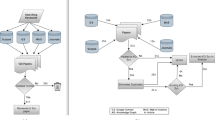Abstract
Increasing amounts of data volume used on the Web and their heterogeneous character make the search for information a challenging task. Several advanced computing methods and technologies propose to incorporate a degree of semantic analysis during the search based on ontologies. Ontology engineering is based on the methods and methodologies for building ontologies combined with engineering process. This paper proposes a hybrid system based on ontology engineering and aiming to enhance web information retrieval results, by combining automatic Modular Ontology building with CBR (CBRModOnto). The system integrates a novel dynamic composition approach of modular ontologies, performed to reorganize the overlapping concepts between the different ontology modules and updates their hierarchy using semantic similarity measure. The search in our system occurs in two main phases. The first one composes modular ontologies and manages the knowledge base, while the second phase manages the CBR process. A demonstration case study presents a scenario to illustrate the proposed system. Our system has been implemented, the obtained experimental results show that hybridization that we propose enables an improvement of query reformulation, predicted ranking score and user’s satistaction.









Similar content being viewed by others
References
Aamodt A, Plaza E (1994) Case-based reasoning: foundational issues, methodological variations, and system approaches. AI communications, pp 39–59
Bechhofer S, van Harmelen F, Hendler J, Horrocks I, McGuinness D, Patel-Schneider P, Stein L (2004) OWL web ontology language reference. W3C Recommendation
Ben Mustapha N, Aufaure M, Baazaoui Zghal H, Ben Ghezala H (2011) Contextual ontology module learning from web snippets and past user queries. In: 15th international conference on knowledge-based and intelligent information & engineering systems, KES 2011
Ben Mustapha N, Aufaure M, Baazaoui Zghal H, Ben Ghezala H (2012) Modular ontological warehouse for adaptative information search. MEDI, vol 2012. pp 79–90
Chklovski T, Pantel PVerbocean: mining the Web for fine-grained semantic verb relations. In: Conference on empirical methods in natural language processing
Christopher D, Schtze H (1999) Foundations of statistical natural language processin. MIT Press, Cambridge, MA
Diaz-Agudo B, Gonzalez-Calero PA (2001) Knowledge intensive CBR through ontologies. In: Proceedings of the 6th UK CBR workshop
d’Aquin M, Schlicht A, Stuckenschmidt H, Sabou M (2009) Criteria and evaluation for ontology modularization techniques Modular ontologies. Springer, Berlin, pp 67–89
Elloumi-Chaabene M, Ben Mustapha N, Baazaoui Zghal H, Moreno A, Sanchez D (2011) Semantic-based composition of modular ontologies applied to web query reformulation. In: Proceedings of the 6th international conference on software and data technologies ICSOFT, pp 305–308
Fragos K, Maistros Y, Skourlas C (2003) Word Sense Disambiguation using WordNet Relations. In: The 1st Balkan conference in informatics
Frieder O (2002) On scalable information retrieval systems. CIKM
Guan-yu L, Li-ning L, Shi-peng L (2008) Design and realization of case-based ontology reasoning. In: 4th international conference on wireless communications, networking and mobile computing
Guarino N (1998) Formal ontology in information systems. In: 1st international conference on formal ontology in information systems. FOIS, pp 3–15
Henriksson J, Assmann U, Johannes J, Zschaler S (2007) Reuseware - adding modularity to your language of choice. In: Proceedings of technology of object-oriented languages and systems Europe 2007
Jarrar M (2005) Modularization and automatic composition of object-role modeling (ORM) Schemes.OTM. In: Proceedings of the object-role modeling (ORM’05) Springer, pp 613–625
Jarvelin K, Kekalainen J (2002) Cumulated gain-based evaluation of ir techniques. ACM Trans Inf Syst 20(4):422–446
Lassila O, Swick RR (1999) Resource Description Framework (RDF) model and syntax specification. W3C Recommendation, world wide web consortium
Lesk M (1986) Automatic sense disambiguation: how to tell a pine cone from an ice cream cone. In: Proceedings ACM SIGDOC conference, pp 24–26
Miller G, Beckwith R, Fellbaum C, Gross D, Miller K (1990) Introduction to WordNet: an on-line lexical database. In: International journal of lexicography, pp 235–244
Minor M, Staab S (eds) (2002) Architecture-based integration of CBR-components into KM-systems, vol 10 of LNI, pp 81–92
Mitra P., Wiederhold G (2004) An ontology-composition algebra. International handbooks on information systems, Handbook on ontologies edition, Springer, pp 93–117
Navigli R, Faralli S, Soroa A, Lopez de Lacalle O, Agirre E (2011) Two birds with one stone: learning semantic models for text categorization and word sense disambiguation. CIKM 2011:2317–2320
Rissland EL, Daniels JJ (1995) Using CBR to drive IR. In: IJCAI, pp 400–407
Sabou M, Motta E (2006) Modularization : a key for the dynamic selection of relevant knowledge components. In: Proceedings of the ISWC 2006 workshop on modular ontologies
Salton G, Buckley C (1997) Term-weighting approaches in automatic text retrieval. In: Jones S K, Willett P (eds) Readings in information retrieval, Morgan Kaufmann Publishers Inc, pp 323–328
Salton G, McGill MJ (1983) Introduction to modern information retrieval. McGraw-Hill, New York
Sanchez D, Moreno A (2008) Learning non-taxonomic relationships from web documents for domain ontology construction. DKE 64(3):600–623
Stuckenschmidt H, Schlicht A (2009) Structure-based partitioning of large ontologies. LNCS 5445:187–210
Tan P, Steinbach M, Kumar V (2005) Introduction to data mining. Addison Wesley, Reading
Turney PD (2001) Mining the web for synonyms : PMI-IR versus LSA on TOEFL, the twelfth European conference on machine learning. pp 491–499
Watson I (1999) Case-based reasoning is a methodology not a technology knowledge-based systems. pp 303–308
Wei W, Barnaghi PM, Bargiela A (2008) Search with meanings : an overview of semantic search systems. J Commun SIWN:76–82
Zimmermann A, Euzenat J (2006) Three semantics for distributed systems and their relations with alignment composition. In: 5th international semantic web conference, ISWC 2006, pp 16–29
Zghal HB, Aufaure M-A, Ben Mustapha N (2007) A model-driven approach of ontological components for on-line semantic web information retrieval. J Web Eng 6(4):309–336
Author information
Authors and Affiliations
Corresponding author
Rights and permissions
About this article
Cite this article
Besbes, G., Baazaoui-Zghal, H. Modular ontologies and CBR-based hybrid system for web information retrieval. Multimed Tools Appl 74, 8053–8077 (2015). https://doi.org/10.1007/s11042-014-2041-z
Received:
Revised:
Accepted:
Published:
Issue Date:
DOI: https://doi.org/10.1007/s11042-014-2041-z




